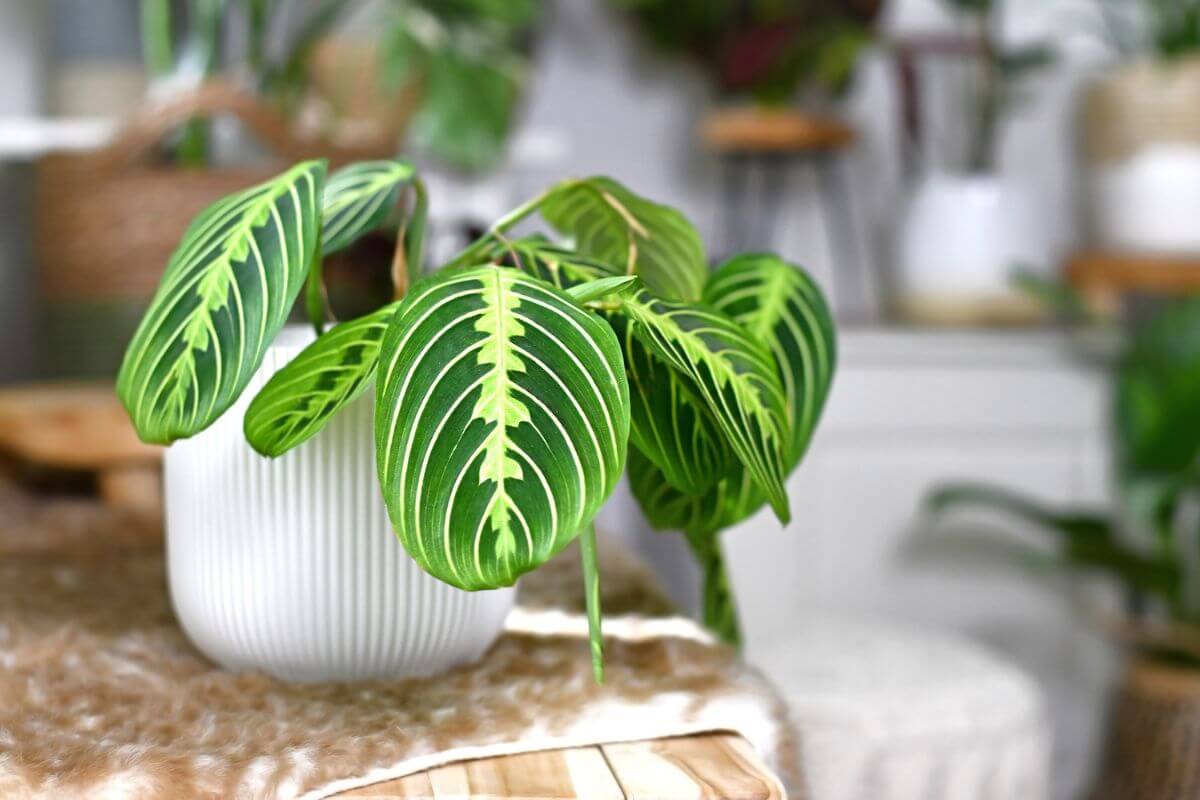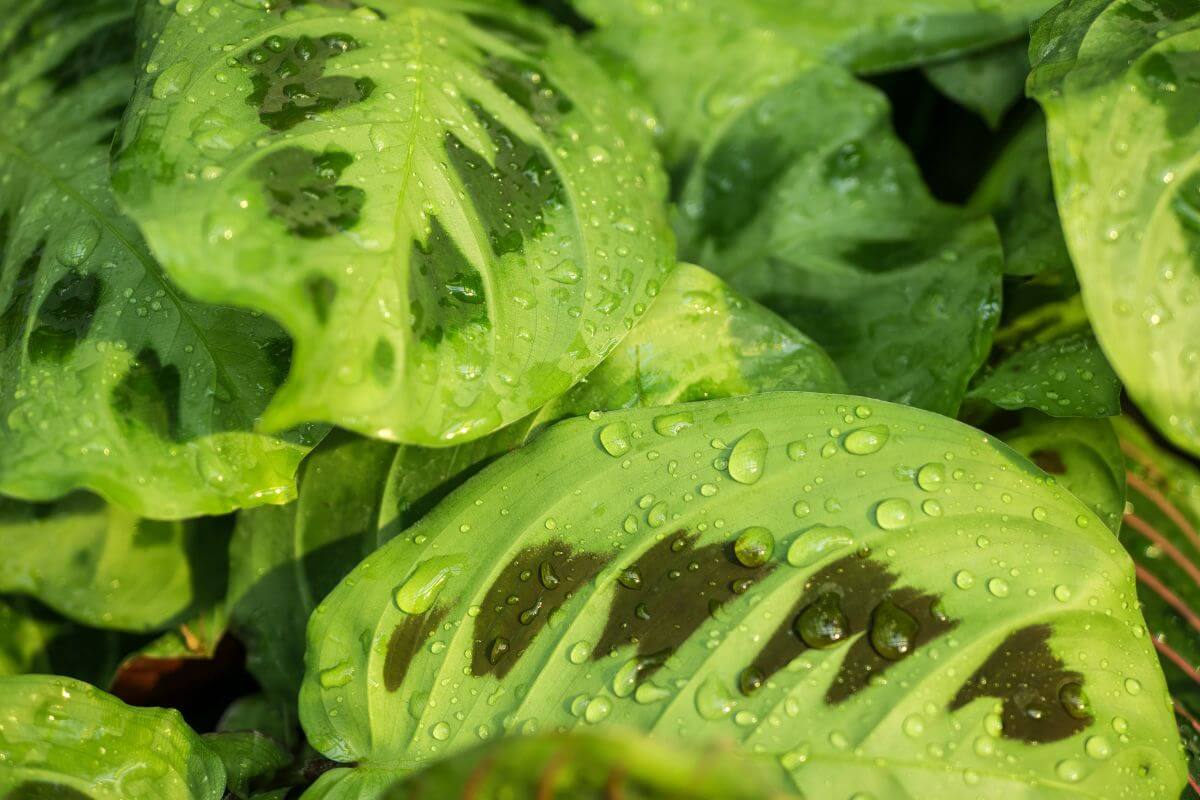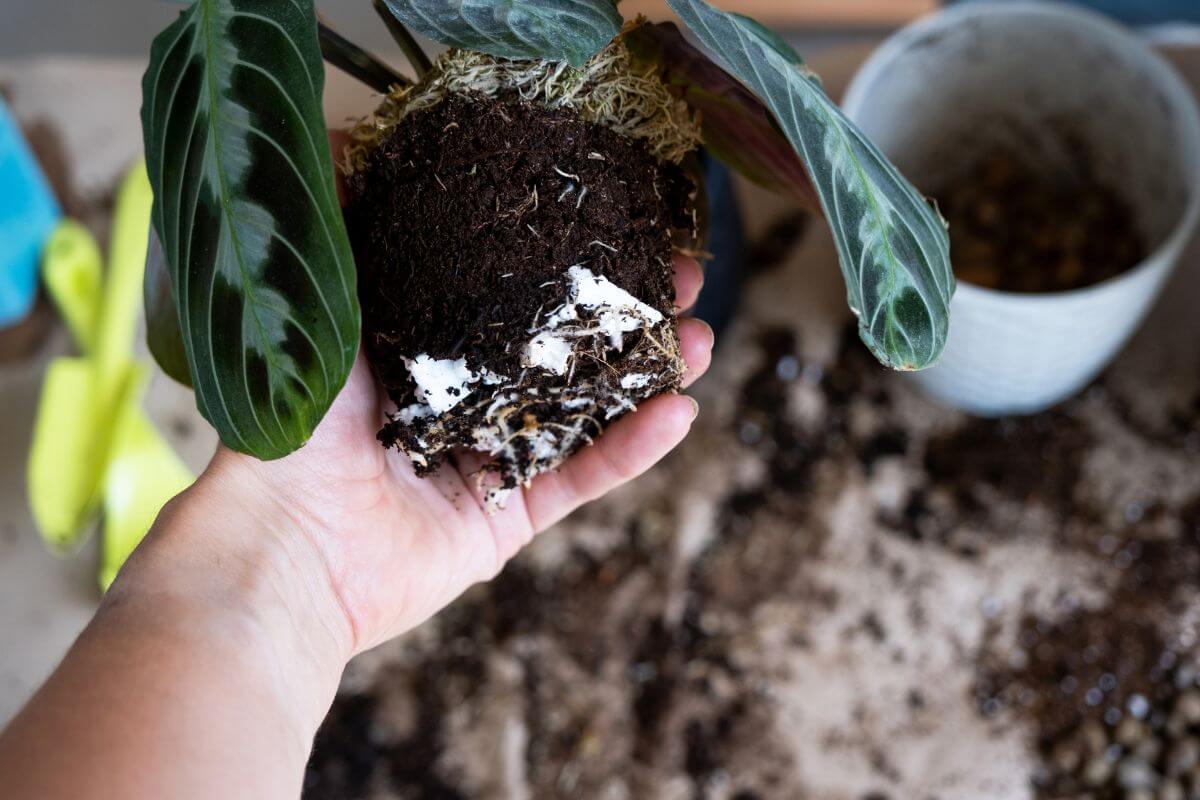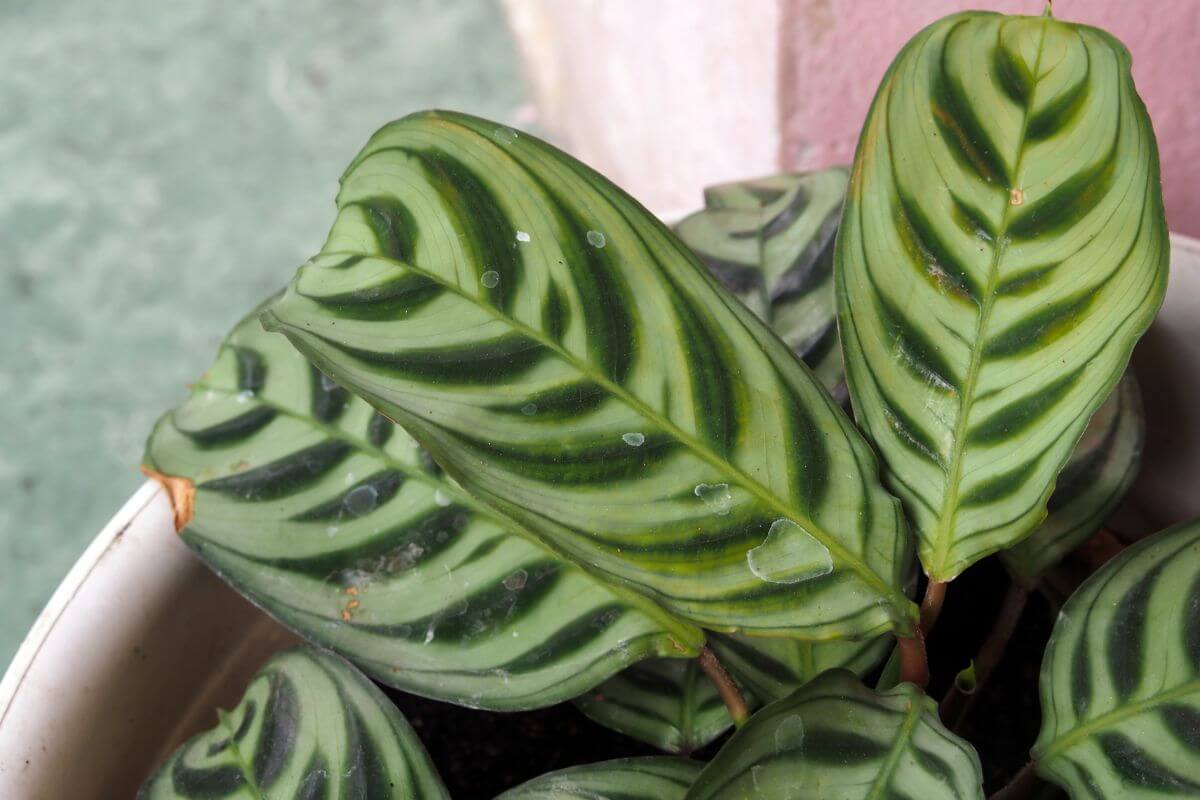Prayer plants are an excellent way to bring peace and tranquility into your home. They also provide a beautiful focal point in your living space.
The name Prayer Plant is the popular name that describes the movement of the plant’s leaves that mimic praying hands. They are flat during the day and fold as if they were a pair of hands in prayer during the night, making them a nyctinasty species (nocturnal).
They make great indoor plants and can be cultivated indoors any time of year.
- Related article: Houseplant Lists
The prayer plant is also a popular houseplant for filtering and cleaning the air of pollutants.
Here’s a guide to get you started on how to care for prayer plants.
Prayer Plant Overview

The Maranta leuconeura, commonly called the “Prayer Plant” is a herbaceous perennial that calls Brazil home where it grows on the floor of rainforests with dappled sunlight. It is one of the several dozen members of the Maranta genus, named for 16th-century Italian physician Bartolomeo Maranta, who was also a botanist.
A member of the arrowroot Marantaceae family, this family of plants includes 31 different genera and over 550 assorted species. The most common is easily recognizable due to the colorful leaves featuring a deep green tint, decorated with red veins and yellow blotches along the central leaf rib.
There are actually quite a few varieties of prayer plants, with the tricolor version being the most common. Among these varieties, the most popular include:
- Maranta leuconeura massangeana – This variety features a dark green leaf with white veins and silver splotches located along the midrib of the leaves.
- Maranta leuconeura erythrophylla – This is the very popular tricolor species, also referred to as a “herringbone plant”. Its recognizable feature is bright, bold red veins.
- Maranta leuconeura ‘Kim’ – This is a black variety with deep gree leaves purple spots, and silver along the veins.
- Maranta kerchoveana – Often called “Rabbit Tracks,” this species has green leaves with darker splotches in two rows visible along the leaves.
- Ctenanthe setosa – A pale silver species with leaves shaped like paddles featuring a fish bone pattern.
- Goeppertia concinnea – Has pale green leaves with a medium green herringbone design.
- Stromanthe thalia – Also called the “Magic Star,” it features leaves shaped like lances that are a darker green with white variegation. They have undersides that range in color from pink to purple.
Prayer Plant Care Guide
The prayer plant thrives in a warm and humid environment. It may reach as much as a foot in height and grows outward, spreading its leaves in all directions.
Humidity will be important as these plants will tend to lose their leaves when grown in dry environments. They also do not do so well when exposed to excessive direct sunlight.
Soil for the Prayer Plant
This plant is not overly finicky about its soil bed as long as it drains well. A standard potting soil is more than adequate. Prayer plants prefer a soil bed that is acidic with a pH of 5.5 to 6.0.
If you want to mix your own soil:
- One part of loamy soil
- Two parts of sphagnum peat moss
- One part of coarse sand or perlite.
To improve the drainage in the soil, place a layer of rocks or pebbles at the bottom of a pot with a drainage hole to be used for planting.
Keep the soil moist and regularly check the soil surface, so it doesn’t completely dry out.
Light for the Prayer Plant

Prayer plants can grow in low, medium, and bright light. They thrive in indirect light, so hanging them or positioning them near a window is fine, but not directly in the window.
They do best when not exposed to direct sunlight. Their leaves are at risk of scorching or can develop splotches with their deep colors fading as a result.
This plant can also do fine in low light conditions, in partial shade, or in full shade. During winter, your prayer plant will go dormant. However, if you provide bright indirect sunlight, they will still continue to grow slowly.
Water and Humidity for the Prayer Plant

Water frequently during the growing season, as the prayer plant is sensitive to drought conditions and will fail, if not die, when left without water.
Avoid watering the leaves and do not allow the soil to become soggy or water-laden to avoid fungal infections. Overwatering or underwatering will place the well-being of this plant at risk. You’ll start seeing yellow leaves if this is the case.
Ideally, Prayer plants should be watered with room temperature water or warm water. If you find that the leaves are browning, try to avoid using tap water. It could be the chlorine or fluoride in your city’s tap water that could be hurting it.
The prayer plant likes humid conditions with a preference for humidity levels between 40 and 60 percent. If you have a humidifier, this plant will be grateful. If not, you can improve the humidity by positioning a small bowl of water in the vicinity of the plant or by using a pebble tray.
Fill a tray with pebbles or stones and add water. Place the container with the prayer plant on this tray of stones. The container should not come into contact with the water, but sit above it.
You can also help by misting your plant’s leaves with water. Placing it next to other plants will help spread humidity as well.
In hte dormant winter months, you also don’t need to water it as much.
Temperature for the Prayer Plant
Environmental temperatures that fall into the 60 to 80 degree Fahrenheit range are preferable.
Cold temperatures can affect the plant adversely, causing leaves to drop off. Be sure to keep it away from door and window drafts during the cold winter months.
Fertilization for the Prayer Plant
The prayer plant is a feeder and will appreciate a dose of fertilizer bi-weekly from the spring through the fall. In the winter, fertilization can be reduced to monthly.
Use a water-soluble standard, all-purpose fertilizer diluted to half strength. Correct dilution is important for this plant, as excess fertilizer will burn the roots and too little will inhibit growth. If you have over-fertilized, the leaves will begin to turn brown.
To prevent the build-up of salts, you can rinse the soil bed every two to three months by watering it heavily with fresh water three times consecutively and allowing the water to thoroughly drain from the pot’s bottom drainage hole.
Pruning and Repotting the Prayer Plant

Even when cared for, it is common for leaves to develop brown tips or leaf edges. Older leaves will gradually fade in color and die. These leaves should be trimmed off with a pair of sterilized scissors.
Brown and yellow leaves should be removed by cutting at the base of the stem. For brown leaf tips, you can just snip off the tip.
Look at the prayer plant for signs you need to repot. Repotting is best to do so at the beginning of the spring.
Should you notice roots emerging from the drainage holes or peeking out from the soil bed surface, your plant is most likely root-bound, and you should repot.
If the soil dries out quickly, causing you to water two to three times weekly, it probably needs fresh soil.
Propagating the Prayer Plant
A prayer plant is an easy plant to propagate, with the quickest method being to divide the root ball when repotting. To propagate the prayer plant through division:
- Remove any excess soil from the root ball gently
- Divide the plant into two or more smaller plants. Each smaller, divided plant should have substantial roots and a couple of stems.
- Initially, your smaller plants should be repotted individually in pots that are not too deep. Keep them moist and warm until you notice new growth.
It is also possible to propagate these plants with cuttings, to do that:
- Cut a stem below a leaf node.
- Dip the cut end in rooting hormone and put it in a glass filled with water.
- Change the water every second day.
- Once you see that the roots have formed, you can transfer your cutting to a pot with a soil.
- Keep the soil bed moist and spray your new plant with a fine mist of water every so often.
Prayer Plant Toxicity and Pets
The Prayer plant is not toxic to humans, dogs, or cats, making it a perfect houseplant for homes with small children and pets.
Prayer Plant Pests, Diseases, and Problems

As with almost all houseplants, the prayer plant can fall prey to pest infestations of mealybugs, scale, and spider mites.
Signs of a pest infestation may be a white powdery substance on leaves or a waxy substance on stems. Leaves may also begin to brown.
Should you notice any of these, you can use a cotton ball with rubbing alcohol or a natural organic insecticide, such as neem oil to cure your plant.
You can use two teaspoons of neem oil mixed with one teaspoon of dish soap and one quart of warm water. Place the mix in a spray bottle and spray the plant’s leaves generously every week until the pests are gone.
You can also remove these pests using a cotton ball with rubbing alcohol. Keep an eye on the plant’s leaves for signs of infestations.
While not subject to disease, the prayer plant is at risk for the cucumber mosaic virus for which there is no treatment. It is characterized by mottles yellow patches on foliage. Infected parts should cut and discarded.
Helminthosporium Leaf Spot is also a disease that can infect these plants. It causes small yellow spots on leaves that gradually increase in size. This strikes when leaves are left wet. Overhead watering should be avoided.
Root rot is a common disease for most houseplants and is caused by overwatering or poorly draining soil. If this happens, repot the plant in fresh soil.
Prayer Plant Care Final Thoughts
If you are looking for a houseplant with impressive foliage, there are different types of prayer plants that offer striking colors and patterns.
Although not considered a low-maintenance houseplant, their beautiful appearance and leaf movements will easily warrant the attention they need in order to thrive.
For other great houseplants, take a look at these:
- Philodendron Plant Care and Grow Guide
- Venus Fly Trap Plant Care and Grow Guide
- ZZ Plant Care and Grow Guide
- Angel Wing Begonia Care and Grow Guide
Prayer Plant Care FAQs
Why is it called a Prayer Plant?
The common name “Prayer Plant” comes from the movement of the plant’s leaves. They lay flat during the daytime, but at night they fold into a position resembling a pair of hands in a prayer.
Why is my prayer plant not praying?
The prayer plant might not be praying or moving because it has too much or not enough light. If you feel that it’s been given 8-10+ hours of bright light, give it more shade for a couple of days to see if it starts praying again. Check that the soil isn’t too wet or dry either. The soil should be moist and well-draining.
Why is my prayer plant flowering?
Your prayer plant is flowering because you’ve cared very well for it! It’s rare that it’ll flower indoors, but it may during the growing season if it’s happy and healthy. People usually only look at the colorful, patterned leaves, but the flowers are beautiful too.
How tall do prayer plants grow?
A typical prayer plant grows to 10 to 12 inches tall. Its bushy spread is usually about the same 10-12 inches, but can spread up to 18 inches wide. With proper care, they can last decades. Without the proper care, it will probably last less than a year.
Are prayer plants toxic?
No, prayer plants are not toxic. They make for great houseplants for homes with pets and small children.


